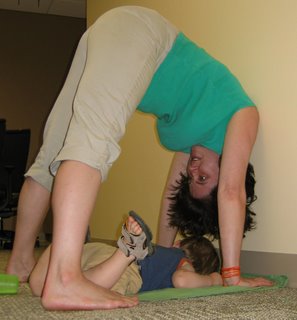When I was at the Y a few weeks ago, I watched a group of 10-year-old kids playing freeze tag in the gymnasium. It was a disparate bunch; some of the kids were really into the game while others were off by themselves on the sidelines. One gymnast-girl was cart wheeling around and doing a cheer routine. Another Harry-Potteresque boy kept throwing himself into a handstand, walking a few steps on his hands and then crashing back to earth. I was impressed with the ease that these two kept unending themselves over the hardwood floor. I was impressed that Harry never lost his glasses.
Why do we stop going upside down? I used to do handstands all the time in junior high PE classes, but the 15 years since seventh grade had been a very loooong time of not being overturned. My first yoga handstand came in a Philadelphia class in 1990. Initially it was a terrifying prospect--the image of a snapped neck and paralyzed back shimmered. The headstand was very basic, supported by a tripod of my forearms and head, against the wall. After a moment of thinking, “Dear God, am I really going to do this,” I kicked up, wobbled then steadied. I was probably only up for about a minute, but when I came down I had a great feeling of lightness (and a bit of a buzz in my neck).
But now, I find inversions a very satisfying series of poses. Some can be thrilling, with a great sense of achievement afterwards, like Adho Mukha Vrksasana (handstands) and Salamba Sirsasana (headstands); others are more calming and centering like Prasarita Padottanasana (Wide–angle forward bend) or Viparita Karani (Legs-Up-The-Wall). This combination of energizing and calming stems from the fact that they require focused upper body strength and a perfectly aligned spine, which engage all the muscles of the torso. At the same time, the head is lower than the heart, which increases the circulation to the brain and settles the mind. Mentally, you have to overcome your fear of falling or being disoriented, which is a real confidence-builder.
It’s such a bold gesture of trust to assume that your arms and torso have the strength and stamina to support you. It’s such a joyful move to kick your legs over your head and let your hair hang down. Once you find that source of trust and joy, an inversion will seem as easy as most other yoga positions. You might not even care that you forgot to take your glasses off… A Short Practice Leading to Salamba Sirsasana (Headstand)
A Short Practice Leading to Salamba Sirsasana (Headstand)
**Don’t try a headstand, until you have learned how to do one with an experienced teacher. S/he will teach you the proper positioning so you don’t hurt your neck. **
1.Tadasana (Mountain Pose)-Feel your tall, aligned spine as you ground down through your feet and stretch up through the top of the head.
2.Hastasana (Overhead Arm Pose)-Add the arm stretch and feel the side ribs lift, while keeping the shoulders away from the ears.
3.Uttanasana (Intense Forward Bend)-Fold from the hips while stretching through the backs of the legs. Keep the weight balanced between the balls and heels of the feet.
4.Adho Mukha Svanasana (Downward Facing Dog)-Keep the spine elongated while the shoulder blades slide down the back (away from the shoulders).
Balasana (Child’s Pose)-Come down to the floor and let the whole body relax
5a. Salamba Sirsasana (Headstand)-Try this against the wall, or, better yet, in a corner so that you have support at your back and heels. Use a folded blanket under the head and forearms for cushioning. Keep the elbows shoulder-distance apart so you can press the forearms to the floor. Kick up each leg separately, until the heels are against the wall. Try to recall the aligned feeling from Tadasana, except this time reach through the head to the floor and the heels to the ceiling.
5b. Half Head/Handstand-if you’re not ready for the full pose, try this modification. Make a tripod with the hands and forearms and place the top of the head (halfway between the ears) on the floor so the palms are resting against the back of the head and the knuckles are gently resting against the wall. OR, place the hands flat on the floor and straighten your arms as in a hand stand. Straighten the legs as for Dog and rest your upper back against the wall, so that only part of the torso’s weight is balanced on the head or hands. Stay as long as you are comfortable. [The little yogi with me, my son Eamonn, is demonstrating a version of Savasana]
6. Balasana (Child’s Pose)-Lower yourself back to the floor and rest as long as you like.
7. Seated twist-Take advantage of your stretched-out torso as you slowly twist the ribcage around the spine, while 8. sitting in Sukhasana (Easy Pose).
9. Savasana (Corpse Pose)-try to recreate the alignment from your Mountain and Headstand, while sinking into the support of the floor. ©Brenda K. Plakans. All rights reserved.

No comments:
Post a Comment